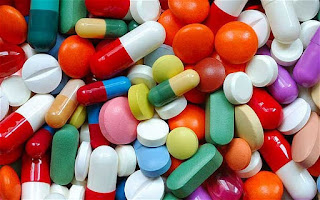Amiodarone:
Trade name: Cordarone, Pacerone
Class:
Antiarrhythmic agent
Pregnancy: (Category D)
Action:
Amiodarone is categorized as a class III antiarrhythmic agent, and
prolongs phase 3 of the cardiac action potential. It has numerous other effects
however, including actions that are similar to those of antiarrhythmic classes
I, II, and IV.
Uses:
• Ventricular fibrillation
• Ventricular tachycardia
• Atrial fibrillation
Dose : by mouth,
200 mg 3 times daily for 1 week reduced to 200 mg twice daily for a further week;
maintenance, usually 200 mg daily or the minimum required to control the
arrhythmia by intravenous infusion: initially 5
mg/kg over 20–120 minutes with ECG
monitoring;
subsequent infusion given if necessary
according to response up to max. 1.2 g in 24 hours "900 mg over 23 hours
'.
Ventricular fibrillation or pulseless
ventricular tachycardia: by intravenous injection over at least 3
minutes, 300 mg Contraindications:
• allergic reaction
• Pregnant and lactation.
• It is contraindicated in individuals with sinus nodal
bradycardia, atrioventricular block, and second or third degree heart block who
do not have an artificial pacemaker.
• Individuals with baseline depressed lung function should be
monitored closely if amiodarone therapy is to be initiated.
• The neonates.
Side effects:
• Cardiovascular
Cardiac arrhythmias, CHF, SA node
dysfunction (1% to 3%); hypotension, sinus arrest (postmarketing).
• CNS
Abnormal gait/ataxia, dizziness,
fatigue, lack of coordination, malaise, paresthesias, tremor/abnormal
involuntary movement (4% to 9%); decreased libido, headache, insomnia, sleep
disturbances (1% to 3%); confessional states, delirium, disorientation,
hallucinations, pseudotumor cerebri (postmarketing).
• Dermatologic
Photosensitivity/Solar dermatitis (4%
to 9%); flushing (1% to 3%); erythema multiform, exfoliative dermatitis,
pruritus, skin cancer, Stevens-
Johnson syndrome, toxic epidermal necrolysis, vasculitis
(postmarketing).
• EENT
Visual disturbances (4% to 9%);
abnormal smell sensation (1% to 3%).
• GI
Nausea, vomiting (10% to 33%);
anorexia, constipation (4% to 9%); abdominal pain, abnormal salivation,
abnormal taste (1% to 3%); pancreatitis (postmarketing).
Nursing considerations:
§ During IV infusion, carefully monitor blood pressure and § Slow the infusion if significant hypotension occurs.
§ Bradycardia should be treated by slowing the infusion or
discontinuing it if necessary. Sustained monitoring is essential because drug
has an unusually long half-life.
§ Report adverse reactions promptly. Bear in mind that long
§ Elimination half-life means that drug effects will persist long
after dosage adjustments are made or drug is discontinued.
§ Be alert to signs of pulmonary toxicity: progressive dyspnea,
fatigue, cough, pleuritic pain, fever.
§ Auscultate chest periodically or when patient complains of
respiratory symptoms. Check for diminished breath sounds, rales, pleuritic
friction rub; observe breathing pattern. Drug induced pulmonary function
problems must be distinguished from CHF or pneumonia. Keep your medical
direction physician informed.
§ Monitor heart rate and rhythm and BP until drug response has
stabilized. Report promptly symptomatic bradycardia.
§ Patients already receiving antidysrhythmic therapy when
§ Amiodarone is started must be closely observed for adverse
effects, particularly conduction disturbances and exacerbation of dysrhythmias.
Dosage of previous agent should be
§ reduced by 30−50% several days after amiodarone therapy is
started



